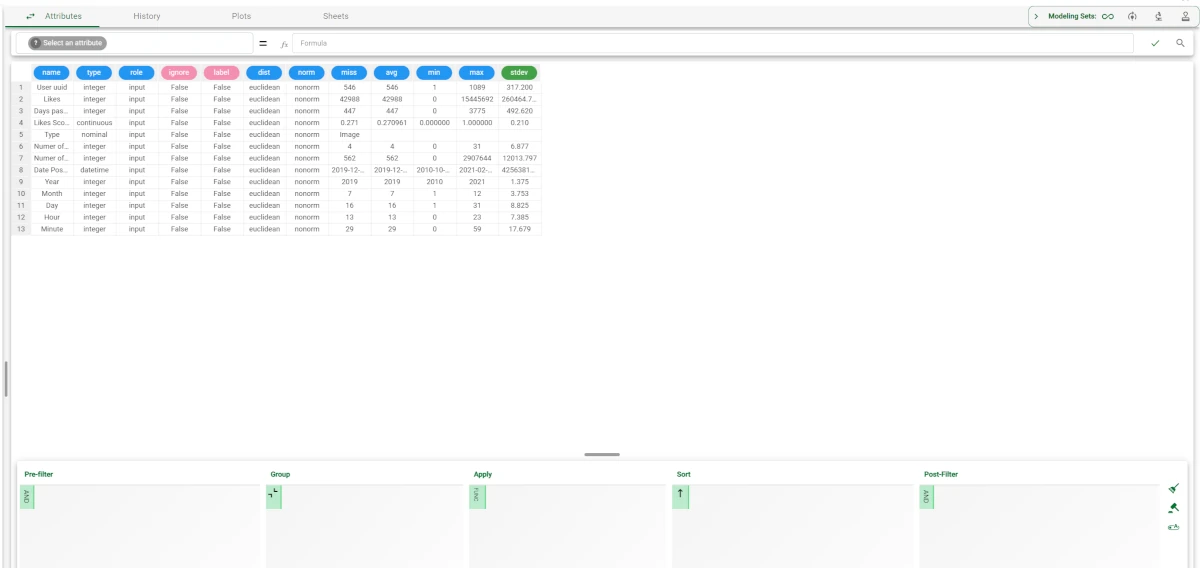The Attributes tab¶
If you want to perform advanced operations on your features, like bulk modify their properties using formulas or query, you need to use the Attribute tab.
This tab is an alternative spreadsheet-like visualization of your data, limited to dataset features or metadata.
It is now accessible by clicking on the double-arrow symbol next to the Data tab.
Once inside the tab, the main data pane will be filled by a spreadsheet representation of your attributes. Moreover, the Attribute list is replaced by a fixed Attribute list containing one entry for each feature property.

Each row of the spreadsheet in the tab corresponds to an attribute of the Data tab: its details are spread over 12 fixed attributes, containing the various feature properties.:
Name: all the dataset’s attribute names are listed.
Type: the corresponding attribute types are listed.
Role: the corresponding attribute roles are displayed.
Ignore: a boolean value reporting if attribute has been ignored.
Label: a boolean value reporting if attribute has been labelled.
Dist: the chosen method to compute the distance between two patterns as regards the selected attribute is displayed.
Norm: the chosen value normalization method is displayed.
Miss: the chosen value used as missing for the attribute is displayed.
Avg: the average value used in modeling for the attribute is displayed.
Min: the minimum value used in modeling for the attribute is displayed.
Max: the maximum value used in modeling for the attribute is displayed.
Stdev: the attribute’s standard deviation.
Important
Since this visualization is always temporary and various operations are made effectively only once standard Data tab visualization is brought back, Save button is disabled in Attribute tab in task toolbar.
Executing bulk operation on attributes¶
In Attribute tab, Formula toolbar and Query manager are still available to filter or sort or executing formula directly on attributes and not on the real dataset data.
See also
Internal behavior of the Formula toolbar or Query manager is perfectly aligned with the ones of the Data tab. We refer then to the sections pointed by previous links for the internal description.
Operations performed in this visualization are applied directly on the columns of the dataset instead of on the rows are usually done in Data tab.
Danger
When operations performed in the Attribute tab are saved into the Data Manager history two extra operations will be added to track switch to Attribute visualization / switch to Data visualization steps. Do not move or erase this operation since this may lead to incorrect behavior or dataset corruption since the internal operations are going to be performed on the real dataset rather than on the metadata additional spreadsheet.
In operating on the Attribute tab you have to pay attention to the following consequences:
Adding or removing a row in this visualization consists in the addition or deletion of features in the original dataset.
Formula execution allows the user to perform a bulk modification of a particular feature property.
Query Make persistent action will erase the unfiltered columns.
From the Attribute list it is possible to add new columns which can be used as temporary features for complex operations. Keep in mind any column different from the list of features listed in this page will not be considered during reverse conversion to Data visualization.
Prerequisites
having a Flow selected with a Data Manager inside
having the Data Manager task opened
Procedure
Click on the double arrow icon located on the left of the Data tab header to switch your data visualization to a Dataset attribute presentation.
Drag and drop the new attribute type on the Pre-filter.
Select some checkbox entry to filter them out from the underlying dataset.
In the Formula toolbar you can write the following formula:
$name = replace($name, "a", "B")Click now on the Reset query icon to empty all the entries in the Query manager.
Click on the double arrow icon located on the left of the Attribute tab header to switch back to data visualization.
Names of attribute of the considered type has been changed replacing the letter
awith the letterB.